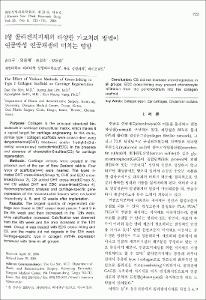KUMEL Repository
1. Journal Papers (연구논문)
1. School of Medicine (의과대학)
Dept. of Plastic Surgery (성형외과학)
I형 콜라겐지지체의 다양한 가교처리 방법이 연골막성 연골재생에 미치는 영향
- Keimyung Author(s)
- Son, Dae Gu
- Department
- Dept. of Plastic Surgery (성형외과학)
- Journal Title
- 대한성형외과학회지
- Issued Date
- 2006
- Volume
- 33
- Issue
- 6
- Abstract
- PURPOSE: Collagen is the principal structural biomolecule in cartilage extracellular matrix, which makes it a logical target for cartilage engineering. In this study, porous type I collagen scaffolds were cross-linked using dehydrothermal(DHT) treatment and/or 1-ethyl-3-(3-dimethyl aminopropyl) carbodiimide(EDC), in the presence and absence of chondroitin-6-sulfate(CS) for cartilage regeneration. METHODS: Cartilage defects were created in the proximal part of the ear of New Zealand rabbits. Four types of scaffolds(n=4) were inserted. The types included DHT cross-linked(Group 1), DHT and EDC cross- linked(Group 2), CS added DHT cross-linked(Group 3), and CS added DHT and EDC cross-linked(Group 4). Histomorphometric analysis and cartilage-specific gene expression of the reconstructed tissues were evaluated respectively 4, 8, and 12 weeks after implantation. RESULTS: The largest quantity of regenerated cartilage was found in DHT cross-linked groups 1 and 3 in the 8th week and then decreased in the 12th week, while calcification increased. Calcification was observed from the 8th week and the area increased in the 12th week. Group 4 was treated with EDC cross-linking and CS, and the matrix did not degrade in the 12th week. Cartilage-specific type II collagen mRNA expression increased with time in all groups. CONCLUSION: CS did not increase chondrogenesis in all groups. EDC cross-linking may prevent chondrocyte infiltration from the perichondrium into the collagen scaffold.
- Alternative Title
- The Effect of Various Methods of Cross-linking in Type I Collagen Scaffold on Cartilage Regeneration
- Keimyung Author(s)(Kor)
- 손대구
- Publisher
- School of Medicine
- Citation
- 손대구 et al. (2006). I형 콜라겐지지체의 다양한 가교처리 방법이 연골막성 연골재생에 미치는 영향. 대한성형외과학회지, 33(6), 723–731.
- Type
- Article
- ISSN
- 1015-6402
- Appears in Collections:
- 1. School of Medicine (의과대학) > Dept. of Plastic Surgery (성형외과학)
- 파일 목록
-
-
Download
 oak-bbb-2140.pdf
기타 데이터 / 3.82 MB / Adobe PDF
oak-bbb-2140.pdf
기타 데이터 / 3.82 MB / Adobe PDF
-
Items in Repository are protected by copyright, with all rights reserved, unless otherwise indicated.